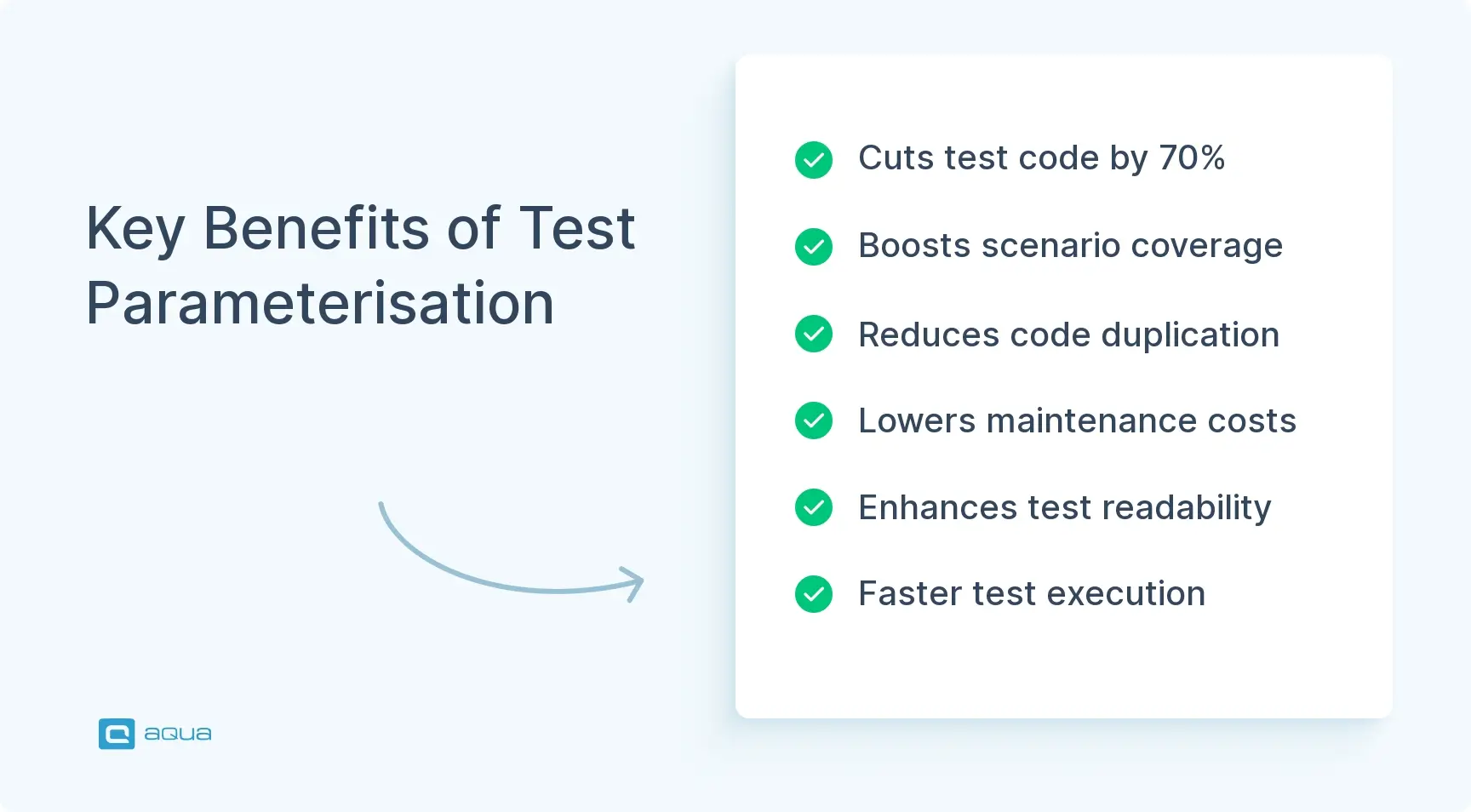What is Test Parameterisation?
Test parameterisation is the technique of running the same test code with multiple sets of data. Rather than creating separate test cases for each data scenario, you design one test that can accept variables and turn your testing approach from boring and repetitive to engaging and dynamic.
Test case parameterisation involves creating templates where the same test logic can be repeatedly executed with different data inputs. Parameterisation in automation testing is essentially the practice of separating your test logic from your test data. It allows for more efficient and maintainable test suites.
It is like a coffee machine that can make different drinks using the same mechanism but with different ingredients. Your test is the machine, and your test data represents the different ingredients you feed into it.
Here’s what test parameterisation looks like in practice:
- Instead of this:
testLogin_validAdmin()
testLogin_validUser()
testLogin_invalidUsername()
testLogin_invalidPassword()
- You create this:
testLogin(username, password, expectedResult)
Key elements of test parameterisation include:
Parameters are like the placeholders in your test method. Instead of hardcoding “test@email.com” in your login test, you use a variable like userEmail that gets filled with different values each time the test runs.
Data sources feed your parameters. Maybe you’re pulling usernames from a CSV file your business analyst created, or loading API endpoints from a database, or simply defining test cases in a code array. The beauty is flexibility: your test doesn’t care where the data comes from.
Test frameworks make the magic happen. Tools like JUnit, TestNG, or Pytest handle the heavy lifting and automatically run your test template once for each data set and report results separately. This approach transforms several painful testing scenarios. Form validation becomes manageable when you can test dozens of input combinations without writing dozens of methods. API testing gets cleaner when one test method handles all your endpoint variations. Database queries, cross-browser scenarios, and performance benchmarks benefit from the same template-and-data approach. What do you win here? When requirements change, you update one test method instead of hunting through countless duplicates.
So the beauty of parameterisation is its simplicity: write once, test many times. It transforms test automation from a collection of similar scripts into a lean, maintainable testing framework.
Benefits of Test Parameterisation
Understanding how parameterisation works is one thing. Seeing what it does for your daily testing life is where your motivation kicks in. Parameterised testing should not be just a nice-to-have feature, because it has a game-changing potential on how you handle test automation. Here’s why you should make it part of your testing strategy:
- Massive time savings: Write one test case instead of dozens. A single parameterised test can replace countless individual tests, cutting development time by up to 70%.
- Improved test coverage: Test more scenarios without extra effort. By feeding in different data sets, you can easily cover edge cases, boundary values, and typical usage patterns.
- Reduced code duplication: Keep your test codebase DRY (Don’t Repeat Yourself). Less duplicate code means fewer places for bugs to hide in your test suite.
- Lower maintenance costs: When requirements change, you only need to update one test instead of multiple similar ones. This means fewer hours spent on test maintenance.
- Better test readability: Well-structured parameterised tests make it clear what’s being tested and with what data, making your tests more valuable as documentation.
- Data-driven insights: By systematically testing with varied inputs, you can identify patterns in how your application responds to different data types.
- Faster test execution: Running parameterised tests is often more efficient than running multiple individual tests due to reduced setup/teardown overhead.
Real teams see real results. According to industry research, teams implementing test parameterisation report up to 40% reduction in test creation time and 60% faster test maintenance.
While these benefits of test parameterisation are great, one of the biggest bottlenecks teams face is creating comprehensive test data sets that drive meaningful parameterised tests. Manually crafting hundreds of parameter combinations with valid emails, edge case inputs, boundary values, and realistic user scenarios is time-consuming and often incomplete. You’ll frequently end up with insufficient test data coverage, missing critical edge cases, or spending more time creating test data than writing actual test logic. The promise of parameterisation falls short when you’re limited by the time and creativity required to generate diverse, meaningful test data sets. Parameterisation streamlines manual testing as well, allowing you to easily run test cases with multiple data sets—whether that’s three, five, or more.

This is where comprehensive Test Management Systems become essential for successful parameterisation strategies. aqua cloud provides a centralised platform that seamlessly manages both your parameterised test logic and the extensive data sets that drive them. Its AI-powered test case generation can rapidly create comprehensive parameter combinations, while native integrations with automation tools like Selenium, Jenkins, and TestNG ensure your parameterised tests integrate smoothly with existing CI/CD pipelines. Nested test cases functionality allows you to have reusable test cases. Instead of manually creating hundreds of parameter combinations, aqua cloud can generate comprehensive test data sets in seconds, complete with valid inputs, boundary conditions, edge cases, and realistic user scenarios tailored to your specific testing needs. With 100% traceability and coverage visibility, aqua cloud helps you track which parameter combinations have been tested, correlate results across different data sets, and maintain clear documentation of test execution patterns.
Transforms 100% of your parameterisation from chaos into a well-orchestrated testing strategy
When to Use Parameterised Tests
Let’s say you’re about to write your fifteenth test for the same login form, this time checking how it handles emojis in usernames. Or maybe you’re facing an API with twelve different endpoints that all need the same validation checks. Your gut tells you there’s got to be a better way. There is. But parameterisation isn’t always the answer. Use it wrong, and you’ll create tests that are harder to debug than the simple duplicates you started with. Use it right, and you’ll wonder how you ever lived without it. Here’s when parameterised testing becomes your secret weapon:
Input Validation Testing: When you need to verify how your application handles different input values, parameterisation is your best friend. Perfect for:
- Form field validation with various inputs (valid emails, invalid formats, special characters)
- Password strength checking with different password combinations
- Number field testing with boundary values, negative numbers, and decimals
API Testing: APIs need to handle various request parameters gracefully:
- Testing endpoint responses with different query parameters
- Verifying how an API handles various authentication tokens
- Checking response codes across different request payloads
- Parameterisation in API testing allows for comprehensive validation of response formats, error handling, and performance across different data scenarios.
Data-Driven Scenarios: When the same functionality needs testing with multiple data sets:
- E-commerce checkout flows with different product combinations
- Financial calculations with various input figures
- User registration flows with different user types
Cross-Browser/Cross-Device Testing: To ensure consistent behaviour across platforms:
- Verifying UI elements render correctly across browsers
- Testing responsive design across different screen sizes
- Checking feature parity between desktop and mobile experiences
Configuration Testing: When your application behaves differently based on configuration:
- Testing with different language settings
- Verifying functionality under different permission levels
- Checking behaviour with feature flags on/off
Regression Testing: When you need to repeatedly verify the same functionality works with different inputs:
- Running core functionality tests with expanded data sets
- Verifying fixed bugs don’t recur with varied inputs
The key is to use parameterisation when you have a consistent test flow that needs to run against variable data. If the test steps change significantly based on input, separate test cases might be more appropriate.
Implementing Test Parameterisation in Automation Tools
You’re sold on the concept. You can practically taste the time you’ll save and the bugs you’ll catch. But now comes the reality check: how do you actually make this happen in your current testing setup? We have good news for you: every major automation framework has figured this out already. The syntax might look different, but the core principle stays the same across tools. Whether you’re deep in Java with JUnit, Python’s Pytest, or managing everything through Jira’s Xray, there’s a path forward. Let’s see how parameterisation translates into real code:
JUnit 5 (Java)
JUnit 5 offers robust parameterisation support through its @ParameterizedTest annotation:
@ParameterizedTest
@ValueSource(strings = {"john@example.com", "alice@company.co", "test.user@domain.org"})
void validateEmail(String email) {
assertTrue(EmailValidator.isValid(email));
}
For more complex scenarios, you can use @CsvSource:
@ParameterizedTest
@CsvSource({
"john@example.com, true",
"invalid-email, false",
"@missing.com, false"
})
void validateEmailWithExpectedResult(String email, boolean expectedResult) {
assertEquals(expectedResult, EmailValidator.isValid(email));
}
TestNG (Java)
TestNG uses data providers for parameterisation:
@DataProvider(name = "loginData")
public Object[][] createLoginData() {
return new Object[][] {
{ "admin", "correct_password", true },
{ "admin", "wrong_password", false },
{ "unknown", "any_password", false }
};
}
@Test(dataProvider = "loginData")
public void testLogin(String username, String password, boolean expectedResult) {
assertEquals(loginService.attempt(username, password), expectedResult);
}
Pytest (Python)
Pytest makes parameterisation clean and readable:
@pytest.mark.parametrize("username,password,expected", [
("admin", "correct_password", True),
("admin", "wrong_password", False),
("unknown", "any_password", False)
])
def test_login(username, password, expected):
assert login_service.attempt(username, password) == expected
External Data Sources
Most frameworks support loading test data from external sources:
- CSV files: For simple tabular data
- Excel spreadsheets: For more complex data structures
- JSON/XML files: For hierarchical data
- Database queries: For dynamic, up-to-date test data
This separation of test logic and test data makes your automation more maintainable and allows non-technical team members to contribute test scenarios.
Ready to see the magic of parameterised testing in action? This interactive simulator lets you experience firsthand how data-driven testing can transform your approach from writing dozens of repetitive test methods to a single, elegant parameterised test. Simply click to open the simulator, switch between traditional and parameterised modes, and watch as the code generation demonstrates the dramatic difference in maintainability, efficiency, and lines of code. Play with different test scenarios like login validation, email testing, or API endpoints to see how parameterised tests scale beautifully while traditional tests quickly become unwieldy.
🚀 Interactive Test Parameterization Simulator (Click to open)
Experience the power of data-driven testing in real-time
🎯 Test Scenario
📊 Test Parameters
💻 Traditional Test Implementation
Best Practices for Implementing Parameterisation
You’ve seen the frameworks, you understand the syntax, and you’re ready to dive in. But here’s where most teams stumble: they treat parameterised tests like magic that automatically makes everything better. The reality is that poorly designed parameterised tests can be worse than the duplicated mess you started with. The difference between parameterisation that saves your sanity and parameterisation that destroys it comes down to discipline. Follow these battle-tested practices, and you’ll build tests that actually make your life easier:
Keep Parameter Sets Focused
The temptation is real: why not test login, logout, and password reset all in one parameterised test? Because when it fails, you’ll spend more time figuring out what broke than if you’d written separate tests.
- Limit each parameterised test to validate one specific aspect of functionality
- Avoid testing multiple unrelated scenarios in the same parameterised test
- Create parameter sets that tell a clear testing story
Structure Your Data Thoughtfully
Your future self will either thank you or curse you based on how you name and organise your test data. Make it obvious what each parameter represents and why it exists.
- Name your parameters clearly to indicate what they represent
- Organise related test data together for easier maintenance
- Include descriptive names for each test case iteration for better reporting and test case management
- Structure your data with a clear purpose:
Good example with clear parameter names
@pytest.mark.parametrize("email, is_valid", [
("user@domain.com", True), # Standard email
("no-at-symbol.com", False), # Missing @ symbol
("spaces in@email.com", False) # Contains spaces
])Select Test Data Strategically
Random test data is lazy test data. Every parameter should be there for a reason, such as testing something specific about your application’s behaviour.
- Include boundary values (min, max, just below/above thresholds)
- Add common “happy path” cases that should always work
- Include edge cases that might break your application
- Test with realistic data that matches actual user behaviour
Improve Readability and Maintainability
Six months from now, someone (probably you) will need to understand and modify these tests. Write them like that person has no memory of why you made these choices.
- Add descriptive comments to complex parameter sets
- Use parameterisation frameworks that support named parameters
- Consider extracting huge data sets to external files
Ensure Good Test Isolation
Parameterised tests can fail in subtle ways when test iterations interfere with each other. One bad data set shouldn’t poison the entire test run.
- Make sure each test iteration is independent of the others
- Properly reset your test environment between iterations
- Don’t rely on test execution order for parameter sets
Handle Failed Iterations Properly
When a parameterised test fails, you need to know exactly which data combination caused the problem and whether other combinations still work.
- Configure your framework to continue testing after a failed iteration
- Ensure failure reports clearly identify which parameter combination failed
- Consider using soft assertions for data validation to see all failures
Balance Coverage and Execution Time
It’s easy to go overboard and create parameter sets with hundreds of combinations. Your CI pipeline will hate you, and the extra coverage often isn’t worth the execution time.
- Avoid test parameter explosion (too many combinations)
- Prioritise critical parameter combinations over exhaustive testing
- Use sampling techniques for very large parameter spaces
Document Your Parameter Sources
Test data that comes from nowhere and is maintained by nobody eventually becomes stale and useless. Make data ownership clear from the start.
- Document where the test data comes from and how it’s maintained
- Include information about data generation for synthetic test data
- Make it clear how to update or extend parameter sets
Example: Well-Structured Parameterisation
// External data file reference with documentation
/**
* Payment validation test using data from src/test/resources/payment_scenarios.csv
* Format: amount,currency,expected_status,description
* Add new scenarios by extending the CSV file
*/
@ParameterizedTest(name = "{3}: {0} {1} should be {2}")
@CsvFileSource(resources = "/payment_scenarios.csv", numLinesToSkip = 1)
void validatePayment(double amount, String currency, String expectedStatus, String description) {
PaymentResult result = paymentService.process(amount, currency);
assertEquals(expectedStatus, result.getStatus());
}
The challenge of implementing these best practices becomes more complex as your parameterised test suites grow. You frequently struggle with organising extensive parameter sets, maintaining external data sources, ensuring proper documentation of test data origins, and providing clear visibility into which parameter combinations are failing across different test execution cycles. Manual tracking of parameterised test results often becomes impossible when dealing with hundreds of data-driven test variations.
Aqua cloud is specifically designed to handle these parameterisation complexities at scale. aqua’s centralised hub automatically organises and tracks your parameter sets, providing complete visibility into test data sources and execution patterns. Its AI-powered capabilities can generate limitless test data for your parameterisation in seconds, while native bug-tracking and recording features capture detailed context about which specific parameter combinations trigger defects. With seamless integration to external data sources and automation frameworks, aqua cloud ensures that your parameterised testing strategy remains maintainable and provides actionable insights as your test suites scale, making the difference between parameterisation that saves time and parameterisation that creates maintenance overhead.
Streamline 200% of your test parameterisation efforts with an AI-powered solution
Test Parameterisation Pitfalls and How to Avoid Them
As we mentioned above, some teams that try parameterised testing end up worse off than when they started. They create tests that are harder to debug, slower to run, and more confusing than the duplicated code they replaced. The irony is brutal. You adopt parameterisation to make testing easier, but poor implementation turns it into a maintenance nightmare. The good news is that these failures follow predictable patterns. Learn to spot them early, and you’ll avoid the most common traps:
Overcomplicating Test Cases
The “kitchen sink” approach feels efficient at first: why not test everything in one parameterised test? Because when it fails, you’ll spend hours untangling what went wrong.
• Pitfall: Creating parameterised tests that try to test too many variations at once
• Solution: Keep each parameterised test focused on validating one specific aspect
• Fix Example: Split a complex test that verifies login, navigation, and data entry into separate parameterised tests for each function
Parameter Explosion
Your test suite starts with 10 parameters and grows to 200. Your CI builds take forever, and you’re testing combinations that add zero value. More isn’t always better.
• Pitfall: Creating too many parameter combinations that exponentially increase execution time
• Solution: Use equivalence partitioning to reduce test combinations while maintaining coverage
• Fix Example: Instead of testing every possible combination of 5 parameters (which could be hundreds), strategically select 15-20 combinations that cover important scenarios
Unclear Test Failures
“Test failed” tells you nothing. Which parameter combination broke? What was the expected behaviour? Without context, debugging becomes guesswork.
• Pitfall: Test reports that don’t clearly identify which parameter combination failed
• Solution: Use descriptive test naming patterns that include parameter values
• Fix Example:
@ParameterizedTest(name = "Login with {0}/{1} should return {2}")
@CsvSource({
"admin,right_pw,SUCCESS",
"admin,wrong_pw,FAILURE"
})
void testLogin(String user, String password, String result) {
...
}
Hard-coded Test Data
You embed test data directly in your code because it’s faster to write. Six months later, updating a single data point requires code changes, deployments, and developer time.
• Pitfall: Embedding test data directly in code, making it difficult to update
• Solution: Externalise test data to configuration files or databases
• Fix Example: Move from embedded arrays to CSV files or database queries for test data
Poor Data Organisation
Random test data is like a junk drawer: you can’t find anything when you need it, and you’re never sure what’s actually useful.
• Pitfall: Random, unstructured test data without a clear purpose
• Solution: Organise data into logical groups with clear purposes
• Fix Example: Structure your test data file with sections for boundary cases, typical usage, and edge cases
Data Maintenance Overload
You create comprehensive test data sets that cover every conceivable scenario. Now you spend more time maintaining test data than writing actual tests.
• Pitfall: Creating so much test data that it becomes unmaintainable
• Solution: Generate test data programmatically where appropriate
• Fix Example: Write a data generator that creates email addresses following specific patterns instead of manually maintaining hundreds.
Test Interdependence
Your parameterised tests work perfectly when run in sequence but fail randomly when run in parallel. Each test iteration assumes the previous one left the system in a specific state. • Pitfall: Parameterised tests that depend on the results of previous iterations • Solution: Ensure each test iteration is completely independent • Fix Example: Reset the application state before each test iteration rather than assuming a clean state from the previous test
Ignoring Failed Iterations
One parameter combination fails, and your entire test suite stops. You miss discovering that 15 other combinations also have problems.
• Pitfall: Stopping test execution after the first failed parameter combination
• Solution: Configure your test framework to continue after failures
• Fix Example:
# In pytest
@pytest.mark.parametrise("input, expected", [...])
def test_feature(input, expected):
try:
assert process(input) == expected
except AssertionError:
# Log the failure but don't stop the test run
pytest.fail(f"Failed for input {input}")
Missing Context in Reports
Your test reports show “15 passed, 3 failed”, but don’t explain what those failures mean for your application. Context is everything.
• Pitfall: Test reports that only show pass/fail without context
• Solution: Add meaningful descriptions to your parameter sets
• Fix Example: Include a description parameter in your test data that explains what aspect each combination is testing
Brittle Parameterisation Framework
You build a custom parameterisation solution because the existing ones don’t quite fit your needs. Now you’re maintaining testing infrastructure instead of writing tests.
• Pitfall: Custom parameterisation solutions that break easily
• Solution: Use established, well-maintained test parameterisation libraries
• Fix Example: Switch from a homegrown solution to using pytest’s built-in parameterisation or JUnit’s parameterised tests
By recognising these common pitfalls early, you can design your parameterised tests to be robust, maintainable, and effective at finding bugs without creating a maintenance nightmare
Conclusion
Test parameterisation, as we learned in this article, is a fundamental shift in how we approach QA automation with test management systems. By separating test logic from test data, you gain the ability to validate countless scenarios without the burden of maintaining duplicate test code. The result? More bugs are caught with less effort. We’ve also explored implementation approaches across popular test automation frameworks and examined best practices that keep your parameterised tests clean, focused, and maintainable. Remember that successful parameterisation is about balance: testing enough combinations to be thorough without creating a parameter explosion. The next time you find yourself copying a test case just to change a few input values, stop and ask yourself: Is this a job for parameterisation testing?


















